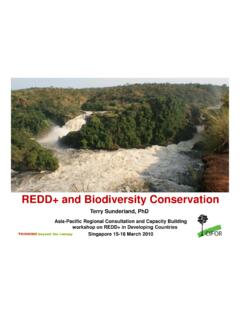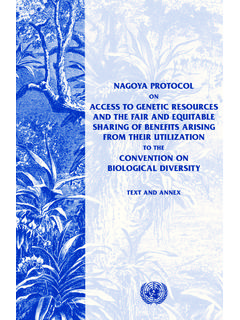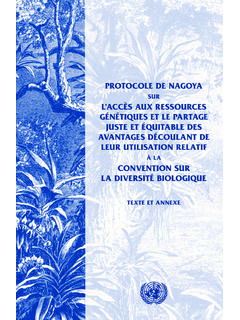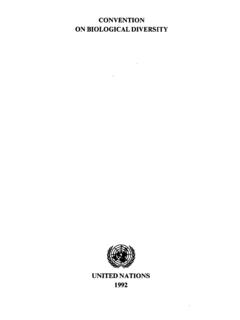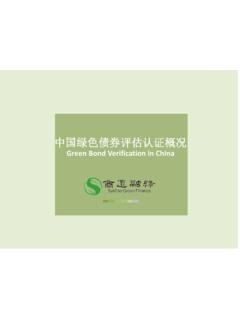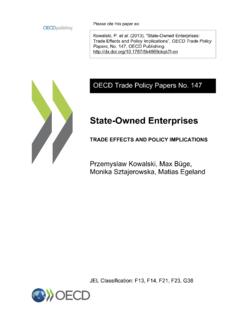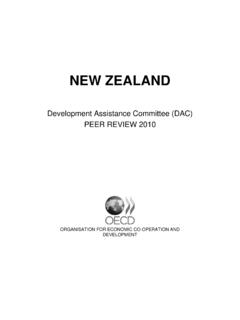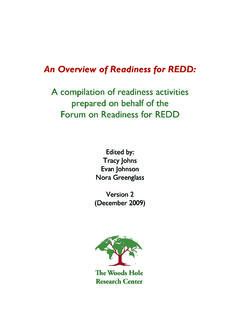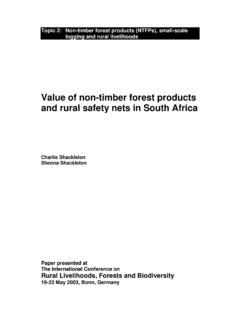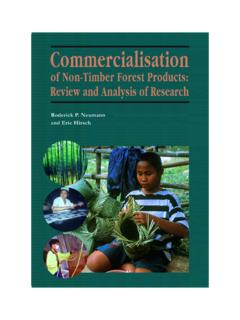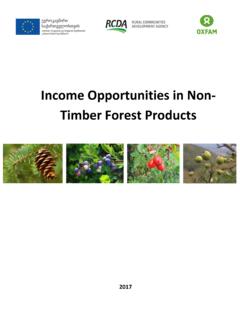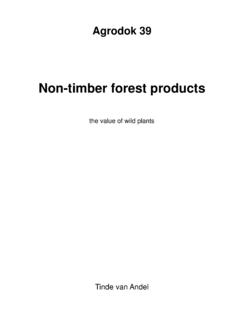Transcription of SUSTAINABLE MANAGEMENT OF NON …
1 6 SUSTAINABLE MANAGEMENTOF NON-TIMBERFOREST RESOURCESCBD Technical Series of the Convention onBiological DiversitySustainable MANAGEMENT of non- timber forest resourcesNovember 2001 Published by the Secretariat of the Conventionon Biological Diversity Copyright 2001, Secretariat of theConvention on Biological DiversityThe designations employed and the presentationof material in this publication do not imply theexpression of any opinion whatsoever on thepart of the Secretariat of the Convention onBiological Diversity concerning the legal status ofany country, territory, city or area or of itsauthorities, or concerning the delimitation of itsfrontiers or views reported in this publication do notnecessarily represent those of the Convention onBiological Diversity nor those of the publication may be reproduced for educa-tional or non-profit purposes without specialpermission from the copyright holders, providedacknowledgement of the source is made.
2 TheSecretariat of the Convention would appreciatereceiving a copy of any publications that uses thisdocument as a of the Convention on BiologicalDiversity (2001). SUSTAINABLE MANAGEMENT ofnon- timber forest resources. Montreal, SCBD,30p. (CBD Technical Series no. 6).For further information, please contact:Secretariat of the Conventionon Biological DiversityWorld Trade Centre393 St. Jacques Street, suite 300 Montreal, Quebec, Canada H2Y 1N9 Phone: 1 (514) 288 2220 Fax: 1 (514) 288 6588E-mail: MANAGEMENT of non- timber forest resourcesiForewordThe Convention on Biological Diversity (CBD),negotiated under the auspices of the UnitedNations Environment Programme (UNEP), wasadopted in 1992 and entered into force in aims are the conservation of biological diver-sity, the SUSTAINABLE use of biological resources,and the fair and equitable sharing of benefitsarising from the use of genetic resources.
3 One ofthe major challenges facing the Convention onBiological Diversity is the communication ofresearch results in a way that provides the policymakers, their advisors, the scientific communityand other stakeholders with helpful factors leading to biodiversity loss arehabitat loss and degradation, invasive alienspecies, overuse of resources and pollution. Dueto the complexity of these factors, variousapproaches and strategies are being used toreduce biodiversity loss. All, however, require thebest available scientific information that allowsthe development and implementation of soundmanagement goal of the CBD Technical PublicationsSeries is to contribute to the dissemination ofup-to-date and accurate information on selectedtopics that are important for the conservation ofbiological diversity, the SUSTAINABLE use of itscomponents and the equitable sharing of its ben-efits.
4 A large and growing body of evidence hasclearly established the need to disseminate syn-thesis publications relevant to CBD objectivesand selected reports presented at CBD Technical Publications Series is intended to: Foster scientific and technical cooperation; Improve communication between theConvention and the scientific community; Increase awareness of current biodiversity-related problems and concerns; and Facilitate widespread and effective use ofthe growing body of scientific and technicalinformation on conserving and using bio-logical CBD Technical Publications Series comes ata time when the international communitythrough the Conference of the Parties to theConvention has committed itself to achievingtangible results in all aspects of the sustainablemanagement of biological diversity for socialand economic purposes.
5 We therefore believethat this series will be useful to the broader sci-entific community and those concerned withbiodiversity am very pleased to make available to the scien-tific community and those actively involved inbiodiversity MANAGEMENT the sixth publicationin the CBD Technical Series, addressingSustainable MANAGEMENT of non- timber forestresources. It is my hope that this publication willbroaden our understanding of the complexity ofthe issue and at the same time facilitate theimplementation of remedial measures to reduceor halt biodiversity wish to express my sincere gratitude to all thosewho have contributed in one way or another inthe preparation and production of this ZedanExecutive SecretarySustainable MANAGEMENT of non- timber forest resourcesiiiiiSustainable MANAGEMENT of non- timber forest resourcesAcknowledgementsThe paper was commissioned by the Secretariatof the Convention on Biological Diversity andprepared by the Center for International ForestryResearch (CIFOR).
6 It was then peer reviewedexternally. It was also posted on the website ofthe Convention for commenting by the scientificcommunity at Secretariat of the Convention on BiologicalDiversity wishes to acknowledge the consultantswho prepared the draft of the document: RobertNasi (CIFOR), Tony Cunningham (CIFOR) andJames Chamberlain (US forest Service, SouthernResearch Station). The Secretariat also expressesits gratitude to the following individuals andorganizations for their review and comments :Amha bin Buang (ITTO), Stephan A. Dada, JohnHerity and the Canadian Forestry Service, WilDe Jong, Wulf Killmann (FAO), Jelle Maas(TROPENBOS), Setijati D. Sastrapradja, andDevi ZedanExecutive Secretary1 SUSTAINABLE MANAGEMENT of non- timber forest resourcesTable of ContentsAcknowledgementsTable of ContentsExecutive importance of non- timber forest resources and wildlife to of non- timber forest and cultural causes of unsustainable in socio-economic of cultural and religious 799101112151516171923 SUSTAINABLE MANAGEMENT of non- timber forest resources2 SUSTAINABLE MANAGEMENT of non- timber forest resources3 SUSTAINABLE MANAGEMENT of non- timber forest resourcesExecutive summaryIf policy on SUSTAINABLE MANAGEMENT of non- timber forest resources (NTFR) is to be implemented suc-cessfully, then recognition that there is no "one size fits all" policy is essential.
7 Policies and their imple-mentation practice have to be tailored to local ecological, economic, cultural and political complexity and the diversity of species used are added to by two other factors. Firstly, that the"catch-all" nature of the terms "non- timber forest resources" or "non- timber forest products" (NTFP),which refer to all natural resources from forests apart from sawn timber . Secondly, the fact that NTFR conservation and use sits at the confluence of at least probably more Articles of the CBD than probablyany other component of natural resource the past, plant and bush-meat use values to people have either been disregarded, or if taken intoaccount, then the emphasis has either been on the values of plants or wildlife, rather than both togeth-er. In southern African savannas where community-based natural resources MANAGEMENT programmeshave been developed, the emphasis has been on wildlife rather than plants, fungi or edible insects.
8 Intropical forests, the opposite has tended to be true, with plant products taken into calculations of forestvalue rather than animals. Whether NTFR or bush meat use is considered from the perspective of locallivelihoods or conservation, species loss through overexploitation benefits neither local people nor con-servation in the long term. When a conservation area becomes the focus of high impact harvesting, over-exploitation also undermines the primary goal of any protected area: the maintenance of habitat andspecies diversity. If even monitoring shows that forest or woodland cover are not decreasing, what is hap-pening beneath the canopy may be quite different: populations of high value, vulnerable plant and ani-mal species can be disappearing due to species specific overexploitation.
9 This situation is rarely takeninto account in protected area review makes the following recommendations to the Subsidiary Body on Scientific, Technical andTechnological Advice: To achieve a balance between conservation and SUSTAINABLE use of non- timber forest resources andanimals hunted for bush meat, there is a need to consolidate protected area networks and establishand maintain corridors (Article 8a); Ecosystem level planning and the MANAGEMENT of harvested or hunted populations must take placethrough a process of consultation, which takes relevant scientific, local and indigenous knowledgeinto account. Ecosystem level and harvested/hunted population MANAGEMENT plans need to bedeveloped with an understanding of the social, economic, ethical, religious and political factors thateither encourage resource conservation or lead to resource depletion.
10 Development and implemen-tation of effective conservation and resource MANAGEMENT plans may need legislative reform beforemanaged use of non- timber forest resources provides and incentive for conservation as a form ofland-use (Article 8k); Land-use planning and sitting of infrastructure (roads, new settlements) both need to take protect-ed areas, their adjacent conservancies or co- MANAGEMENT areas and the requirements for maintain-ing viable populations of valued, but vulnerable species into account. Legislative change, technicalsupport and economic incentives for ecological restoration of wildlife corridors and for the controlof invasive plant and animal species may be necessary for maintenance or re-establishment of viablepopulations of indigenous plant and animal populations; A folk taxonomy initiative should therefore be formed as a separate, new component within the cur-rent Global Taxonomy Initiative, which has been established as a means of promoting taxonomy andtaxonomic tools for implementation of the Convention (Articles 7 4 SUSTAINABLE MANAGEMENT of non- timber forest resources SUSTAINABLE levels of harvest of popular, less resilient plant and animal species need to be establishedand monitored as part of an adaptive MANAGEMENT process.)
